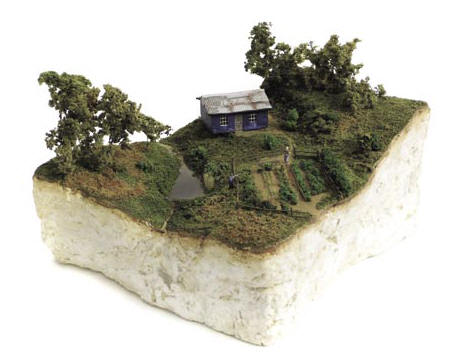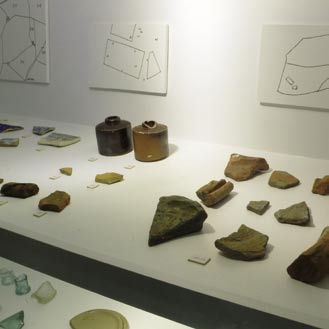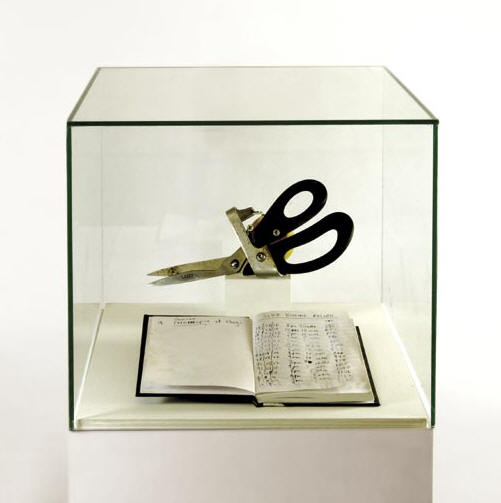|
|
| home | features | exhibitions | interviews | profiles | webprojects | gazetteer | links | archive | forum |
|
Paul Chaney: The Lonely Now Goldfish, Penzance
Up until now Paul Chaney has been something of a cult figure as an artist in Cornwall. His show at Goldfish was his first substantial solo exhibition and in it he was given the freedom and the space to show a range of work in different media. With more than a year's lead-up time, it was also an opportunity to consolidate and develop a significant new body of work, and to announce his 'arrival' to a wider audience.
Animism forms the basis of most ancient religions in which, typically, shamanistic rituals are used to connect with animal spirits as a way of harnessing their magical energies and power. Something similarly ritualistic seemed to have motivated 'One for Sorrow', Chaney's morbidly disturbing video called of a dead magpie, whose animated carcass we see being flown like a puppet around the field. Chaney frequently records his relationships with other wild animals with whom he shares his living space. He is troubled by the fact that his actions in cultivating his land results in the death of many of them, however, and another video nearby depicts the artist burying a vole that had been killed by his lawnmower. The viewer has to look down on the floor where a small monitor is installed. Watching closely, it becomes apparent that the recently dead vole is pregnant, for as Chaney is laying it to rest, the babies inside its abdomen can be seen moving.
Drawings in the stairs lead up to one of the strongest works in the show: '24 hour F I E L D C L U B' (picture right (detail)). Display cases have been been big in contemporary art since Jeff Koons and Damien Hirst adopted them in the 80s. Here Chaney gives the museum-style display case a new twist, by providing an old wine cabinet with lights powered by a solar battery and filling it with fragments of pottery and other finds from his small-holding. These were catalogued and dated by a local archeologist, and are shown with a lightbox of the display case in situ in the field. 'Slug'o'metric' in the landing is a record of the slugs killed by Chaney during his work on the land, that seems more playful than the other dead-animal works. Perhaps Chaney recognises that our concern for the natural world does not necessarily extend to slugs. The same is not true of puffins, who with their bright beaks and squat demeanour, evoke instant empathy and pathos. Probably the most affecting work in the show: 'The library at St Kilda (everybody loves a puffin)' seen earlier at the Buoys Club show in Falmouth, comprises one such bird sent to Chaney from St Kilda, in the empty rib-cage of which he has made a miniature library. Rich with meaning, and apparently inadvertant literary associations, this work has a strong poetic quality.
The fact that Goldfish is willing and able to put on a show of this quality is a measure of its ambition and confidence, which extends far beyond the remit of the typical 'local gallery'. In fact Goldfish has been concerned with developing the talents of uniquely local artists, in many cases then exporting them outside the county. Chaney's work seems well suited to this aspiration being both predicated on a rural lifestyle (the work couldn't have been made in London), and able to speak of issues that transcend the 'local' both in their contemporary relevance and the sophistication of the language used.
|
|
|

 Chaney's
lifestyle is important to understanding his art. He lives modestly in a
field in which he owns, and is largely self-sufficient, obtaining energy from a solar cell array and growing
his own food. The work in Goldfish showed a formal diversity,
but was united by being an honest and penetrating reflection on
the complexities and contradictions thrown up by his quest to find a
simple and sustainable way in which to live in the 21st Century. This
struggle, which has huge ethical as well as practical dimensions, was
treated lightheartedly in the BBC sitcom 'The Good Life'. At Goldfish it
was
taken further and given a more serious and considered treatment by
Chaney: forming the inspiration for a collection of art objects that
carries significant philosophical and political
meanings, and allows us to share in this very personal struggle with
him.
Chaney's
lifestyle is important to understanding his art. He lives modestly in a
field in which he owns, and is largely self-sufficient, obtaining energy from a solar cell array and growing
his own food. The work in Goldfish showed a formal diversity,
but was united by being an honest and penetrating reflection on
the complexities and contradictions thrown up by his quest to find a
simple and sustainable way in which to live in the 21st Century. This
struggle, which has huge ethical as well as practical dimensions, was
treated lightheartedly in the BBC sitcom 'The Good Life'. At Goldfish it
was
taken further and given a more serious and considered treatment by
Chaney: forming the inspiration for a collection of art objects that
carries significant philosophical and political
meanings, and allows us to share in this very personal struggle with
him.  In the same downstairs space are
three small sculptures including a recent work depicting a carefully
constructed miniature model of one man hiding in bushes about to shoot
another. Called 'Goodbye Old Man (in respect of the need for field
defences)' (picture above) it seems to be either a portrayal of the bigotry experienced
by those who choose alternative lifestyles, or of the way in which farming
practices world-wide are linked to land-ownership and territorial
conflicts. Perhaps it is both.
In the same downstairs space are
three small sculptures including a recent work depicting a carefully
constructed miniature model of one man hiding in bushes about to shoot
another. Called 'Goodbye Old Man (in respect of the need for field
defences)' (picture above) it seems to be either a portrayal of the bigotry experienced
by those who choose alternative lifestyles, or of the way in which farming
practices world-wide are linked to land-ownership and territorial
conflicts. Perhaps it is both. Eco-art or environmental art is
often worthy but hypocritical, or finger-waggingly issue-laden but superficial. Some
artists, many based in cities, are happy to adopt the look or the label
but don't really do anything with it. This was evident eg in the
disappointing book published by the RSA called 'Land Art: a cultural
ecology handbook'. Chaney instead seems to engage with debates about the
environment and the landscape at a level that, because it is a true
reflection of his lifestyle, is much more honest, unselfconscious and complex.
Eco-art or environmental art is
often worthy but hypocritical, or finger-waggingly issue-laden but superficial. Some
artists, many based in cities, are happy to adopt the look or the label
but don't really do anything with it. This was evident eg in the
disappointing book published by the RSA called 'Land Art: a cultural
ecology handbook'. Chaney instead seems to engage with debates about the
environment and the landscape at a level that, because it is a true
reflection of his lifestyle, is much more honest, unselfconscious and complex.